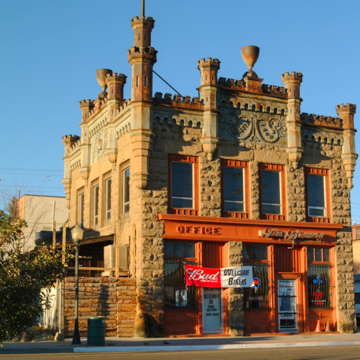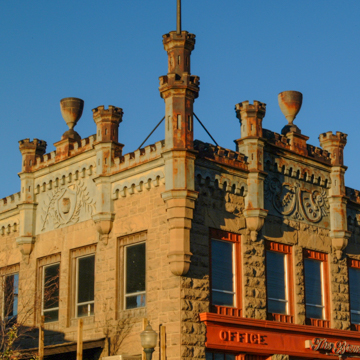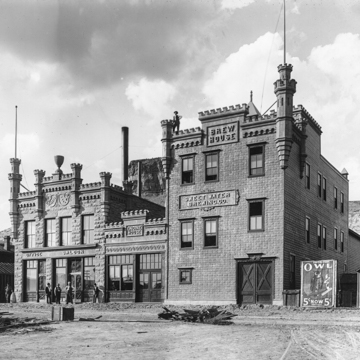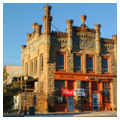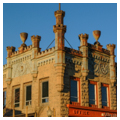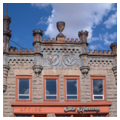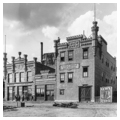You are here
The Brewery
The Sweetwater Brewing Company was built by German brewmaster Hugo Gaensslen in 1900. Gaensslen modeled the building after the Chicago Water Tower, a famous landmark in the city where he spent his childhood. The design of the building might also have been influenced by the castles along the Rhine River in Germany, where his parents grew up. The brewery building was built of large, rock-faced blocks of locally quarried sandstone laid in regular courses and originally consisted of three parts: the brewhouse, the engine house, and the office/saloon. Only the latter section remains.
The two-story, square-plan building has two primary facades on the south and the west. The south facade is divided into two storefronts; the east portion was the saloon; the west was the office. Above the storefronts runs a pressed metal cornice with raised letters spelling “office” and “saloon.” The most notable feature of the building is the castellated roofline. Capped with a corbelled tin cornice and crenellated parapet, it has crenellated stone towers that originate on the upper walls and rise above the parapet at the corners and the centers of the south and west elevations. The crenellation and tower motif continues around the southeast corner. The tower on the southwest corner is taller than the rest and supports a flagpole. The central portion of the south and west parapets are raised and have their own set of small towers flanking a large metal “cup.” A decorative frieze on the south facade is also embossed in tin and reads, “Erected 1900”; a matching frieze on the west facade features a beer keg within a shield.
Located on Railroad Avenue, once the most prominent business street in Green River, the Sweetwater Brewing Company was built on the site of an earlier brewing business opened by Adam Braun in 1872—the first brewery in the Territory of Wyoming. Hugo Gaensslen, an experienced brewmaster and graduate of the United States Brewers’ Academy in New York, purchased the business in 1891. Eight years later he took out a $20,000 loan to demolish the old frame structure and build his more imposing complex. The brewery employed between thirty and forty men and produced a beer that won silver and bronze medals at the St. Louis World’s Fair in 1904 and the Lewis and Clark Centennial Exposition in Portland, Oregon, in 1905. With the passage of the Volstead Act in 1919, Gaensslen was forced to suspend his brewing operation. He renamed the business the Sweetwater Beverage Company and produced soft drinks and near beer, but the business never recovered from Prohibition, and closed when Hugo Gaensslen died in 1931.
Over the next few decades, the building housed several businesses including a laundry and a plumbing shop. The three-story brew house and engine house were eventually demolished. In 1976, the remaining section of the building was converted to a bar appropriately named The Brewery, which remains a popular today.
References
Lauritzen, Ruth. “Green River Gems Nomination.” Unpublished manuscript. Sweetwater County Historical Museum, Green River, WY, 1999.
Werner, Brian and Henry Chadey, “Sweetwater Brewery,” Sweetwater County, Wyoming. National Register of Historic Places Inventory – Nomination Form, 1982. National Park Service, U.S. Department of the Interior, Washington, DC.
Writing Credits
If SAH Archipedia has been useful to you, please consider supporting it.
SAH Archipedia tells the story of the United States through its buildings, landscapes, and cities. This freely available resource empowers the public with authoritative knowledge that deepens their understanding and appreciation of the built environment. But the Society of Architectural Historians, which created SAH Archipedia with University of Virginia Press, needs your support to maintain the high-caliber research, writing, photography, cartography, editing, design, and programming that make SAH Archipedia a trusted online resource available to all who value the history of place, heritage tourism, and learning.

